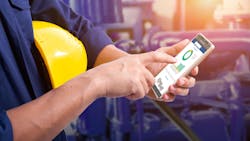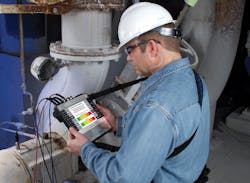It is no secret that the plant environment is changing with respect to the workforce. An entire generation of workers is rapidly leaving the workplace and experienced replacements are becoming harder to find. Moreover, the personnel in the plant are digital natives, and the newest of them have gained their experience, whether at school or in other industries, with constant access to critical data and information.
Providing an efficient, competitive plant environment means taking advantage of the new skills these digital natives can harness, and this requires a data foundation, which cannot be accomplished with traditional, route-based condition monitoring. So why are so many plants still slow or reluctant to embrace the online condition monitoring tools necessary to create a connected environment, where automation helps plant personnel make the best decisions?
In many cases, it is because they make decisions based on some common misconceptions about online condition monitoring. Clearing away those misconceptions can help end users define a path for a more efficient, effective program.
Misconception: If I do not have people walking through the plant on regular rounds, we might miss something
Often, reliability managers fear moving to online condition monitoring because they worry their best people will not see what is happening in the plant. After all, if the best reliability personnel are monitoring from workstations instead of the plant floor, how will they stay connected with the holistic health of the plant?
However, the reality is reliability personnel freed from rounds are ultimately more likely to be actively involved on the plant floor. Maintenance rounds are typically low-value, and high-time expenditure, activities. When plant personnel are performing rounds — especially in an environment with a small staff — they are typically missing other opportunities for improvement.
Online condition monitoring does not eliminate the role of skilled reliability personnel, but rather redeploys those individuals to focus on analyzing, tracking and solving critical threats and defects in need of attention. Moreover, today’s best condition monitoring software provides instant plant health information accessible on mobile devices, so technicians are not tied to desks or predefined rounds (Figure 1).
Digital data collected via online condition monitoring is also easily stored and accessed via secure cloud technologies — a solution that drives even more value from an organization’s network of experts. Once data is available in the cloud, reliability teams can effectively crowdsource help from their colleagues and other trusted resources, such as third-party experts, making it easier to solve even the most complex problems.
For example, teams can use collaborative software platforms to connect to vendor resources, who can help them deep dive into data to navigate the most vexing plant issues. They can also connect to their own experts — who may be across the state, country or world — without incurring the cost and time of travel.
Misconception: I do not have the time or budget to overhaul my plant with all new digital technologies
When a plant has been running for years or decades and has accumulated a wide variety of old and new equipment, the thought of overhauling everything — and the associated cost — can be overwhelming. This is where it is important to remember that many of the most successful condition monitoring programs were not born of plant-wide overhauls, but rather small pilot and proof-of-concept projects that were scaled as each proved a sufficient return on investment (ROI).
Condition monitoring is not all or nothing. Many companies start small and build organizational maturity by piggybacking off a series of small wins. These companies often start with 10 or fewer monitoring points, gradually scaling until they are monitoring hundreds or thousands of devices. In doing so, they help ensure that every active monitoring point has purpose and has proven its worth, without risking a large, single investment.
Successfully implementing a proof-of-concept or pilot condition monitoring program hinges on selecting the right application of the technology. All too often, reliability teams choose to monitor devices that do not need online monitoring because they are low risk and low value to the process. The problem with this strategy is it is hard to prove ROI when the asset being monitored is not causing a loss to begin with.
A better strategy is to find a small number of bad actor assets impacting measurable key performance indicators in the plant. Such an approach will enable the reliability team to actively measure the performance increase gained by continuous monitoring of the device, and then translate that improvement into hours and/or dollars saved. Often, that savings can be the funding for the next pilot project, creating a sustainable program that grows year by year.
As organizations start small and scale, trusted automation partners can provide key guidance to help design successful pilots. An automation partner can help a reliability team perform an evaluation to find the best candidates for success, and then identify easy, cost-effective programs to provide a solid foundation for future expansion.
Misconception: Adding online condition monitoring would make our handheld monitoring equipment a wasted investment
Instead of rendering existing tools useless, a comprehensive condition monitoring strategy makes tools such as handheld machinery health analyzers even more essential. Much like existing personnel, existing technology can be redeployed for more valuable uses.
As wireless sensing devices come online, and edge analytics technologies begin identifying problems, alerts and alarms will become more frequent. Most organizations cannot stop operations for every alert, but they will still want to identify the root cause and severity to create an efficient maintenance plan. Often, this will require higher frequency or higher resolution data, or the running of additional tests.
The more complex the machinery being monitored, the more likely it is that additional troubleshooting steps — such as coherence testing, bump testing and cross-channel analysis — will be necessary to fully identify the cause of a problem. Expert technicians, who are no longer preoccupied with scheduled maintenance rounds, can use the plant’s existing handheld analyzers to gather more data for deeper analysis, and to then plan and prioritize asset maintenance (Figure 2).
Instead of creating a sunk cost, online condition monitoring helps reliability teams regain productivity to draw more value from the limited resources they already have in place.
Misconception: Our people cannot handle all this technology. They are used to the old ways
Often, people say the newest generation of workers are digital natives, but that statement is not as accurate as it could be. The reality is, nearly all of today’s workers are digital natives. Most people bank, pay bills, order food and consume entertainment through digital interfaces, and they expect to do the same in the workplace.
Even the most experienced personnel can benefit from information at their fingertips to help them make better decisions. The best reliability personnel do not want to be stuck at workstations looking at old interfaces. Rather, they want instant access to data via modern software tools to help them make better decisions, whether they are in the control room, on the plant floor or even at home between shifts. These types of tools provide ubiquitous connectivity to make life easier (Figure 3).
Moreover, the youngest personnel will expect digital interfaces that provide information to help them better perform their jobs. Many of today’s students are being trained on online condition monitoring equipment and edge analytics devices, and they will expect the same level of technology in their workplace.
For example, the University of Tennessee installed Emerson’s AMS Asset Monitor edge device in its Reliability and Maintainability Center, and the same or similar technologies are installed at other institutions with reliability-focused programs. Students enrolled in other technical programs regularly visit the innovation centers of automation vendors to help familiarize themselves with the technologies they will use as they enter their careers. In short, the most valuable, best-trained reliability personnel will come out of school knowing how and expecting to use online condition-monitoring technologies. Attracting, retaining and leveraging those workers requires modern digital tools.
Positioned to compete
Continuous condition monitoring provides insight below the water line to expose potential threats and defects to reliability and maintenance teams. These systems provide information in an intuitive format, any time of day or night and anywhere personnel may be located, to help plan for necessary interventions. This continuous visibility helps teams unlock the predictive maintenance strategies that can help extend the life of existing assets and eliminate threats to plant uptime.
While it is easy to be overwhelmed by the idea of a move to continuous condition monitoring, the reality is there is no better time to begin that transition. Doing so will enable improved efficiency and performance, while attracting the best talent to the organization, which is vital in today’s increasingly competitive recruitment and retention environment.
[BIO]
Erik Lindhjem serves as vice president and general manager of Emerson’s Reliability Solutions business. In this role since June 2021, Erik is focused on driving digital transformation through plant asset management of automation assets and machinery that enables clients to reach top quartile performance.
Emerson
www.emerson.com




